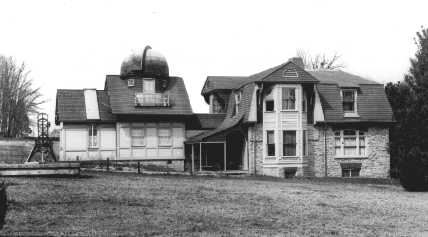The Cunningham Building: Swarthmore's Other Observatory

(photo courtesy Friends' Historical Library)

If you've ever walked by the Scott Foundation Offices, you've seen them. Atop the otherwise unremarkable looking building, on the Parrishward side, are a pair of green observatory domes. These domes are the only remaining sign that the building was once Cunningham Observatory, housing the Astronomy department of the college as well as Swarthmore's first Professor of Astronomy, Susan Cunningham.
Susan Cunningham had been a Professor of Mathematics at the college since 1871, and had been involved with Swarthmore from its founding in 1864. By 1888 she was Mathematics Department Chair, and the Board of Managers gave her permission to build and equip the building which bears her name on the college campus. She lived in the building until her retirement in 1906, when the new Chair of Mathematics and Astronomy, John A. Miller, took up residence there. Swarthmore paid $100 rent per year to her for the rest of her life, and upon her death in 1921 Cunningham Observatory became college property.
"This observatory is only one of the expressions of the marked influence this great woman and great teacher has had, and in fact is having, upon the college, for she still contributes not only from her material resource, but gives her entire strength and influence to the upbuilding of the college," Miller wrote, in a Popular Astronomy article describing Swarthmore's astronomical resources.
Cunningham equiped her observatory with a 6-inch equartorial refracting telescope, a sidereal clock, a meantime clock, and a chronometer, Miller wrote. Astronomy Professor Wulff Heintz said that this telescope was never used for research--it was of instructional quality, even in 1885.
In 1906, Cunningham persuaded William Cameron Sproul to fund research quality astronomical equipment for Swarthmore. This equipment included a 24-inch telescope and additional equipment housed in the new Sproul Observatory (The upper retangular portion of the building had been the residence of the college President, and the domed portion of the building was built them--the computer science wing was not built until the 1960s). In addition, Sproul provided a photographic telescope for Cunningham Observatory, installed in 1908.
Stephen Loines donated a 6-inch equatorial telescope to Swarthmore in 1910, which Miller described as "a most convenient instrument ... used rather effectively by students who merely want to 'poke around the sky.'" Joseph Wharton (who also funded Trotter and Wharton Dormitory) donated a seismograph. "The instrument is very sensitive. It has recorded earthquakes from all parts of the world. There is a fairly continuous series of seismograms, extending through a long series of years, on file in the observatory," wrote Miller.
By the time of his article (around 1912), Miller wrote, "A considerable number of students use these telescopes for looking up objects, making micrometer measures, etc. The work is voluntary and no college credit is given for it. It can hardly be called serious work, but those who are interested and work faithfully derive a good deal of pleasure and considerable benefit from it."
Cunningham Observatory continued to be used by astronomy-loving students for independent work after the construction of Sproul Observatory. However, the photographic telescope was soon outdated, and Miller loaned it to the Lowell Observatory of Arizona, where Lampland was looking for a 9th planet with photographic telescopes. The first photograph of the planet Pluto was taken with the Swarthmore telescope, although Lampland died before measuring that photographic plate. When Tombaugh later found evidence for the existence of Pluto in the 1930s, he located the earlier photographic plate taken with the Swarthmore telescope in the Lowell archives, and used it to help determine Pluto's orbit. The telescope was returned to Swarthmore upon Lampland's death.
Professor Heintz arrived at Swarthmore in the 1960s. By then, he said, the observatory portion of the building was totally dilapidated, though other portion of the building was still used as a residence. "I would bet that nobody had set foot in there for years," he said, though he had heard that the telescopes were occasionally used for watching meteors and comets in the 1950s. The telescopes and the domes were in ill repair, and some of the optics from the photographic telescope were missing.
In 1972, the Cunningham building became the home of the Scott Arboretum. Professor Heintz wanted only the telescopes. So, the non-functional photographic telescope was mothballed in the basement of Sproul. Around 1985, Lowell Observatory asked if the telescope could be displayed in its lobby, and Heintz agreed to donate the telescope to them, "to get it out of the basement." The original refracting telescope which Susan Cunningham purchased in 1888 was taken by crane from Cunningham Observatory to the roof of the computer science wing of Sproul, where it remains today. Heintz said that this telescope may still be used by any student who has been taught how to use it properly--the key is available to such students from the department secretary.